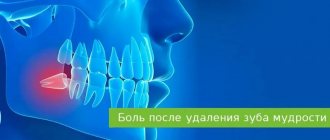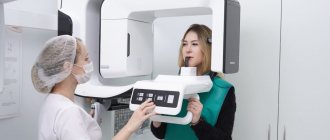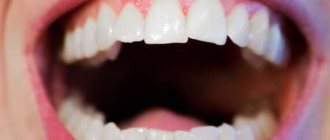Pain after tooth extraction: how long does it last, and is it normal? These and other questions concern patients after dental procedures. Pain syndrome is normal in several cases: early postoperative period, complex removal, simultaneous implantation.
Normally, pain can persist from several days to a week, and its intensity should decrease. The appearance of symptoms such as increased pain, swelling, inflammation, bleeding or the appearance of purulent exudate is a reason to immediately consult a doctor.
How does a postoperative wound heal?
How long the area hurts after tooth extraction depends on many factors. The healing process after tooth extraction is a complex and lengthy process. Removal occurs with a rupture of the dentofacial connection, namely the connection with the alveolar process and the jaw bone.
The recovery process lasts about two to three weeks. Much depends on the surgical protocol, the clinical situation and the characteristics of the body.
Main stages:
- Formation of a blood clot. Forms 1.5-3 hours after extraction. The function of the clot is to protect the wound area from pathogens and secondary infection.
- Active tissue regeneration. The affected mucous membranes are restored, after 3-4 days swelling and inflammation decrease.
- Formation of granulation tissue. After 4-6 days, granulation tissue forms on top of the clot - the basis of a new epithelial layer.
- Granulation proliferation. After a week, the granulation tissue grows, completely covering the socket.
Already on the eighth to tenth day, the wound is completely healed and by the end of the second week a new epithelial layer is formed.
After two weeks, bone tissue begins to renew. After six months, the bone tissue in the area of removal becomes completely healthy.
Main reasons
So why does a tooth hurt after nerve removal? In most cases, this is caused by poor quality work by the dentist. High-quality treatment of canals requires precision, accuracy and excellent mastery of technology, and inattention and careless attitude lead to errors in treatment, which in turn lead to very painful complications.
Here are the possible causes of pain after nerve removal.
The canals are not completely closed with filling material
If the doctor made a mistake when assessing the depth of the canals and did not seal them completely, then over time bacteria can accumulate in the voids and provoke an inflammatory process. This error does not manifest itself immediately: for quite a long time the patient may think that everything is fine. However, sooner or later destructive processes will still manifest themselves - as a rule, sharp pain that appears on its own or when pressing on the tooth. Inflammation in an unclosed canal can lead to destruction of the tooth root, the formation of a granuloma or cyst.
The filling material has gone beyond the root
One of the most common complications is in which, after removal of the nerve, the tooth hurts when pressing and biting food. The situation is exactly the opposite of the previous one: in this case, the cause of pain in the tooth after removal of the nerve is not the lack of filling paste in the canal, but its excess. The paste enters the jawbone, causing irritation, inflammation and the body's immune response to the foreign body. Pain appears immediately after obturation (filling) of the canals, and its intensity directly depends on the amount of paste that has gone beyond the tooth root: the larger the volume of the foreign body in the jaw bone, the stronger the discomfort.
The end of the dental instrument broke off and remained in the canal
This also happens. To extract the pulp and process the canals, very thin instruments are used, which require high precision from the doctor. If manipulations are performed with excessive pressure on the instrument, without the use of a special lubricating gel, or simply carelessly, then the thin end of the endodontic instrument may break off and remain in the root canal. Then access to the canal will be blocked, and its high-quality processing and filling will become impossible. Over time, this will certainly lead to inflammation, pain and destruction of the tooth root.
Perforation of the tooth root occurred during canal treatment
Perforation is a puncture of the root wall during canal processing with an endodontic instrument. It is dangerous in itself: it can lead to inflammation and suppuration of the tissue in the puncture area, but also through the hole, filling material can get into the jawbone with all the ensuing consequences. Due to anesthesia, the patient will not feel the moment of the puncture, but after the effect of the painkillers wears off, he will definitely feel a sharp pain. It is practically not relieved by analgesics.
The carious cavities were not drilled out completely
Another “delayed” complication after nerve removal is when the doctor inadvertently leaves caries-affected tissue in the tooth. A filled tooth may not remind you of itself for several weeks or even months, but sooner or later the unpleasant sensations will definitely return. Pathogenic bacteria will continue the process of tooth destruction, affecting healthy tissue, causing inflammation and pain.
The patient had an allergic reaction to the components of the filling paste
This is the only cause of post-filling complications that does not depend on the actions of the doctor. Individual intolerance to the filling material leads to swelling of the gums, burning, and nagging pain in the area of intervention. After removal of the nerve, the tooth aches, the eyes may become watery, the lips and cheeks may swell, there may be nasal congestion and even a rise in temperature.
Causes of pain
The occurrence of pain after tooth extraction is associated with damage to nerve endings, vascular structures and soft tissues. The peak intensity of pain occurs in the first hours after the cessation of anesthesia. The symptom persists for about 12 hours.
In case of incisions in the gums or damage to the bone tissue, as well as after implantation after removal, toothache may persist for 2-3 days. Pain syndrome also occurs in the case of displacement of the dentition towards the formed void. Therefore, doctors recommend prosthetics as soon as possible after extraction.
Why complications arise
After extraction, a wound is left in the gum and bone in which a blood clot (fibrin) forms. It “seals” the wound, preventing infection, and becomes the basis for the formation of new tissue that fills the space formed after the removal of the 8. After uncomplicated removal, healing lasts about a week. On days 3-4, the blood clot is gradually replaced by granulation tissue, which gradually fills the entire socket. Already after a month, the granulation tissue is completely replaced by connective tissue, and after 3 months - by bone.
Removal of third molars can have negative consequences that appear almost immediately after the intervention. Among the most common complications:
- “dry socket” - when a blood clot does not form or dissolves too quickly;
- paresthesia - damage to the nerve endings around the removed unit;
- alveolitis - inflammation of the socket;
- bleeding;
- cyst - fibrous formation at the site of an extracted tooth;
- endogenous periostitis (flux).
In rare cases, stomatitis, osteomyelitis, jaw trauma, and perforation of the bottom of the maxillary sinus are observed. The occurrence of complications is usually associated with ignoring the dentist’s recommendations regarding oral hygiene during the healing period, decreased immunity, and violation of surgical technique.
Pain during difficult removal
The duration of pain after complex extraction (wisdom teeth, impacted or dystopic incisors) is associated with damage to a larger tissue area. Often such an operation involves making an incision in the gum, sawing out the roots, extracting tooth fragments, and draining an abscess, which increases the scope of the surgical intervention. If your ear hurts after wisdom tooth removal, this may indicate nerve damage.
In some cases, patients complain of persistent discomfort and pain for up to a week. Clinical manifestations such as swelling, swelling of the gums, enlarged submandibular lymph nodes, fever, and malaise are also common.
Methods for removing wisdom teeth
Wisdom teeth, which dentists call figure eights, complete the dentition. It is difficult to reach them with a toothbrush, which is why their enamel is especially susceptible to caries. In addition, they begin to erupt when the rest of the teeth have already grown. Eights sometimes rest against neighboring teeth, contributing to their destruction.
The difficulty of removing wisdom teeth largely depends on the location of the roots and the presence of concomitant diseases (pulpitis, periodontitis):
- if the roots are not intertwined, the tooth grows smoothly and there are no associated diseases, it is removed relatively simply, using forceps or an elevator;
- if the roots are tangled, the tooth is curved or its crown part is destroyed, the tissues around it are inflamed, dentists have to use more traumatic methods: cutting the gum and then applying sutures. In particularly difficult cases, the wisdom tooth is removed under general anesthesia.
Types of pain
The nature and type of pain depends on the type and surgical intervention, the duration of the operation, and the complexity of the clinical process. Clinicians distinguish the following types:
- Aching. It is felt immediately after the anesthesia wears off. Keeps for about 2-4 days. The jaw may ache when opening the mouth or chewing.
- Intense, enduring. Occurs during extraction of a complex tooth with drainage or opening of a purulent cavity.
- Phantom. Occurs after traumatic surgery and may be felt from time to time. Phantom pain occurs with weak immunity and a low pain threshold.
It is difficult to say how intense the pain will be in each specific case, which is why it is so important to follow medical recommendations to prevent complications.
Prevention methods
Tooth extraction is often required when the 3rd molar (molar) is out of position. However, surgery is also prescribed for caries, abscesses and cysts, and injuries. To prevent caries, you should pay enough attention to oral hygiene, undergo regular dental checkups and clean the enamel from plaque and tartar. Immediately after surgery, it is important to observe several conditions that will help avoid complications and headaches:
- use disinfectant solutions for the oral cavity - they clean the wound from pathogenic microflora;
- take only soft, liquid food in the first few days, so as not to further injure the socket;
- Do not remove a blood clot from the postoperative socket yourself, but if it falls out, consult a doctor.
At the Clinical Brain Institute, you can undergo all the necessary examinations, determine the exact cause of the headache and receive a competent treatment regimen. Our center employs only experienced specialists, general and specialized doctors, as well as modern, precision equipment. There are all conditions for quick and high-quality diagnosis, regular examinations, as well as outpatient and inpatient treatment of headaches.
What else can pain indicate?
Severe pain after removal may indicate the development of complications. Pulsating pain that radiates to the ears and submandibular lymph nodes is not normal. The most common causes of complicated postoperative pain are the following factors:
- Violation of treatment protocol. Unfortunately, mistakes do occur, especially in the removal of complex teeth. The techniques and approaches used in different clinics may differ from the standards. Errors include leaving fragments of materials or a splintered tooth root behind.
- Alveolitis. Occurs in the absence of a blood clot. The disease complicates natural healing and interferes with normal tissue regeneration. That is why doctors do not recommend touching the wound with your tongue or rinsing your mouth intensively.
- Dry hole. One of the common complications and the cause of long-term pain after tooth extraction. Despite the moisture of the mucous membranes, bone tissue is visible at the bottom of the wound opening. This problem is typical for smokers during periods of hormonal surges. The doctor seals the wound with a swab containing medication.
- Trigeminal neuritis. Long-term pain persists when a tooth in the mandibular row is removed if the trigeminal nerve is damaged during the manipulation. Damage may be accidental due to structural anomalies or multiple branching of nerve structures.
The likelihood of complications developing is low if the removal protocol, medical recommendations after extraction, and timely response to alarming manifestations are followed.
Can a tooth hurt after nerve removal?
The dental nerve, or pulp, is a thin bundle of nerves, ligaments and blood vessels that fills the inner cavity of the tooth. It is responsible for blood supply and sensitivity, helps maintain enamel strength and serves as a barrier to infections. Carious processes in the oral cavity can lead to inflammation of the pulp - the so-called pulpitis. To prevent inflammation from spreading beyond the tooth root, the dentist, under local anesthesia, removes the nerve, cleans the canals and fills the tooth. After this operation, he completely loses sensitivity: he stops reacting, for example, to hot and cold.
It would seem that a tooth devoid of nerve endings is not capable of causing its owner any unpleasant sensations, but despite this, patients who have tooth pain after removal of a nerve still turn to dental clinics. So why does this happen?
How can you reduce pain?
In the early postoperative period, it is important to follow basic recommendations that reduce the risk of negative manifestations:
- maintain the integrity of the blood clot - do not touch the wound with your tongue, rinse vigorously with solutions or water, just take an antiseptic or herbal decoction into your mouth, hold for a few minutes and spit;
- after a complex removal, take broad-spectrum antibiotics - this is important to prevent the infectious process;
- taking symptomatic medications for up to 2-3 days - in the first days, medications help reduce pain and inflammation;
- use a gel with a cooling effect for intense pain;
- do not eat for two hours after surgery, and eat solid food in the area of manipulation for 5-7 days.
You can reduce the pain if you chew a piece of ginger or propolis on the healthy side of the jaw, apply ice through a handkerchief to your cheek or chin, and rinse with the following ingredients:
- tea tree (10 drops per 500 ml of boiled water);
- steep chamomile decoction;
- decoction of eucalyptus and string;
- soda-salt solution (1 tsp soda, 1 tsp salt, 500 ml water).
The temperature of rinsing solutions should be comfortable - neither cold nor hot. Herbal solutions are best used as an alternative 3-5 days after surgery. In the early period, it is better to rinse the wound and oral cavity generously with water-based antiseptics.
The appearance of pain after tooth extraction is associated with trauma to the deep layers of the jaw structures. The tooth can hurt from several hours to 3-7 days, depending on the severity of the clinical situation and the scope of medical intervention. If questionable symptoms or other signs indicating complications appear, it is recommended to consult a doctor.
Types of deletion
Wisdom teeth (eights, third molars) are larger than other dental units in the row. They differ not only in size, but also in the complex anatomy of the root system. Eight has from 2 to 6 roots
, which are often closely intertwined with each other. Given the complex arrangement of wisdom teeth, when they are removed, a significant wound is created.
The risk of complications will directly depend on how difficult the figure eight extraction was. With simple extraction, when the tooth is intact, the roots are not intertwined, and there are no other pathologies (pulpitis, periodontitis, etc.), the risk of complications is minimal. In such a situation, the doctor uses forceps or an elevator to remove the tooth from the socket.
If the wisdom tooth is incorrectly positioned (horizontal eruption, severe curvature), intertwined roots, significant destruction of the coronal part, or the presence of inflammation, a more global surgical intervention may be required. An incision in the gum, cutting a tooth into pieces with a drill, removing root fragments through the jaw bone and other manipulations significantly increase the traumatic nature of the procedure. Aching pain, swelling after removal of the figure eight, increased temperature (up to 37.5℃), hematoma on the cheek - this is a normal reaction to the intervention, which lasts no more than 5-7 days.
Features of third molars
They differ from other teeth not only in the late stages of eruption and increased vulnerability to carious lesions, but in the anatomical structure of their location on the gum, as well as in the high likelihood of developing various kinds of complications during the process of eruption and removal.
Anatomy of a wisdom tooth
Anatomically, these teeth have the following structure:
- wide tuberous crown;
- on the lower jaw - two roots;
- on the upper jaw – three roots (most often);
- intertwined or fused roots.
Maxillary third molar
They often grow crookedly and do not completely grow out of the gums. It is impossible to save such teeth if they interfere with others or damage the mucous membrane due to constant mechanical impact. But removing them is also not easy.
Wisdom tooth (dens serotinus)
Important! Difficult access to the end of the dentition, the proximity of the masticatory muscles, the influx of gum tissue onto the crown, the interweaving of roots and ligaments - all this complicates the removal of the third molar, and entails serious postoperative consequences.
“Surprises” of third molars
They begin during the process of eruption. The patient experiences unpleasant sensations, but is not immediately able to understand that it is the “eights” that are being cut. Limitation of mouth opening, pain in the gums, itching where the jaws close - all this is perceived as a sign of problems with other teeth or symptoms of an incipient ARVI.
Table. Third molar problems
| Complication | Description |
| Pericoronitis | The tissues surrounding the tooth become inflamed and form a gum “hood”. Food debris constantly accumulates in it, rotting there, producing an unpleasant odor and the formation of microbial plaque. During the course of the disease, the patient feels pain in the jaw when he opens his mouth, or food gets on the tooth. Swelling of the gums and fever may occur. |
| Caries | Location, inclination, poor-quality eruption - all this complicates the hygiene of third molars. When brushing, the head of the brush does not reach the end of the dentition or rests against the jaw bridge. The caries that inevitably arises in this case is almost impossible to cure, since the tooth is inaccessible for dental manipulation. |
| Damage to the mucosa | If, as often happens, the wisdom tooth grows at an outward angle, it constantly injures the cheek mucosa, damaging the tissue and forming ulcers. |
| Shift of the dentition | There is often not enough space in the gum for the last molar. In an attempt to occupy its niche, it crowds out the rest of the teeth in the row, which by the time the third molar erupts, have already positioned themselves and are fixed without taking into account its appearance. For example, very often when a posterior molar erupts, the fangs and almost the entire jaw hurt. |
| Cyst | The development of a cyst at the roots or in the tissues around the wisdom tooth, which is a consequence of its impaction, is a clear indication for the removal of this tooth. |
| Compression of the trigeminal nerve | It happens that the tooth germ is located in close proximity to the nerves that penetrate the jaw joint. As the tooth grows, it puts pressure on them, pinching the trigeminal nerve and causing pain. |
- Ear hurts after wisdom tooth removal
Complications of alveolitis
If alveolitis is not treated in a timely manner, the following complications may develop:
- Odontogenic sinusitis is an inflammation of the maxillary sinus caused by the spread of infection from the inflamed sockets after the removal of premolars or molars of the upper jaw;
- Phlegmon - purulent inflammation spreads to the surrounding soft tissues;
- Acute periostitis - pus accumulates in the periosteum area;
- Odontogenic osteomyelitis is a purulent-necrotic lesion of the jaw bone;
- Sepsis - an infection enters the bloodstream, causing it to become infected.
Alveolitis itself is not so dangerous, but its complications are life-threatening. Therefore, if you notice symptoms of alveolitis, contact your doctor immediately.
When to see a doctor
About 25% of patients experience a return visit to the surgeon after extraction of a posterior molar. This occurs due to the development of complications after surgery. When is it time to go for a follow-up appointment to prevent serious problems?
- The pain lasts longer than a week, does not decrease, on the contrary, it increases.
- New symptoms appear, the temperature rises, pain spreads to the entire jaw, to the ear area, to the temporal part.
The pain began to spread to the ear
- The swelling of the cheek intensifies and does not subside, occupying a larger area.
- Putrid odor from the mouth.
A putrid odor appeared and pus began to leak
- Any discharge from the socket, especially purulent discharge.
All this may mean the presence of a disease that began as a result of infection of the socket, the presence of foreign bodies in it (fragments of dental bone or other objects). The doctor will again order an x-ray, clean the hole, treat it with an antiseptic, and, if necessary, apply drainage. He will prescribe medication and give recommendations for gum care that will help normal healing.











